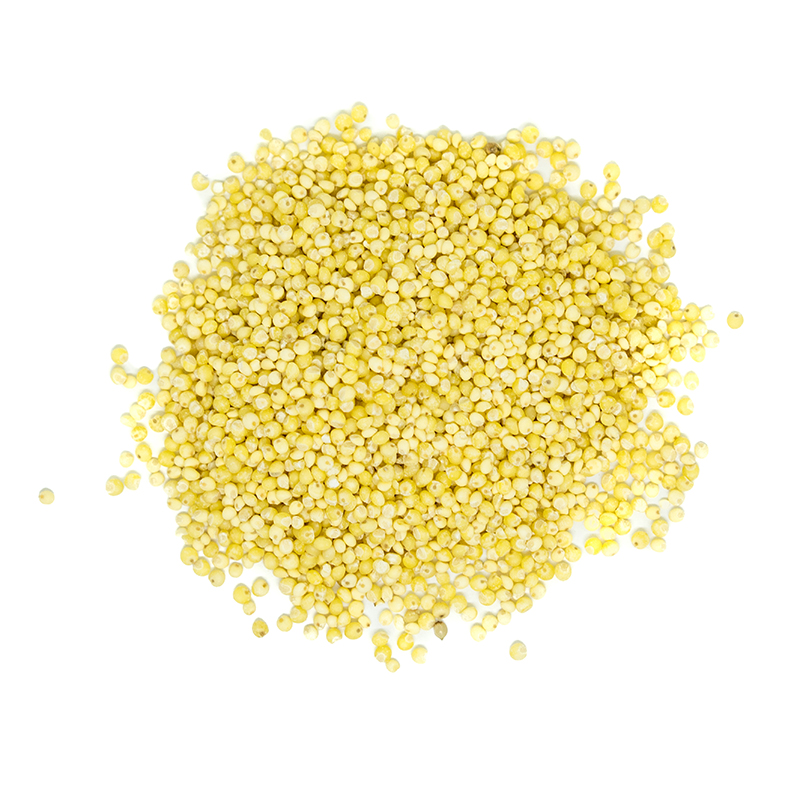-
Description
Millets are small-seeded grasses that flourish in difficult growing conditions. The grain resembles small yellow beads, and has a mildly sweet, nutty flavour.
-
Directions
Rinse 1 cup grain. Add 2 cups boiling water in a pot and cover. Reduce to simmer and cook for 45 minutes or until millet is tender and liquid has been absorbed. Millet can also be cooked in a rice cooker. For a creamy porridge, stir frequently, adding extra water. Try toasting the grain before cooking for a nuttier flavour.
-
Uses
Whole cooked millet can be used as a side dish to replace rice or mashed potatoes, or cooked with extra liquid to be served as a porridge. It can be used in both sweet and savoury dishes, and as a substitute for other grains for nutritional diversity. Try substituting for buckwheat, rice, or quinoa. Whole or cracked millet can be added to breads and muffins to add flavour and texture.
-
Storage
When stored in a cool (preferably less than 60˚F) and dry location (less than 65% humidity), shelf life is approximately 1 year.
-
Nutrition
Nutrition Facts Per 1/4 cup (45 g) Amount % Daily Value Calories 170 - Fat 2 g 3% Saturated Fat 0.3 g - + Trans Fat 0 g 2% Carbohydrate 33 g - Fibre 4 g 14% Sugars 1 g 1% Sugar Alcohol - - Protein 5 g - Cholesterol 0 mg - Sodium 0 mg 0% Potassium 100 mg 2% Calcium 0 mg 0% Iron 1.25 mg 7%
| SKU | Unit Size |
|---|---|
| 23311 | 12 x 400 g |
| 23312 | 2 kg BULK |
| 23314 | 10 kg BULK |
| 23315 | 22.7 kg RM |
-
Description
-
Directions
-
Uses
-
Nutrition
-
Storage
-
Millets are small-seeded grasses that flourish in difficult growing conditions. The grain resembles small yellow beads, and has a mildly sweet, nutty flavour.
-
Rinse 1 cup grain. Add 2 cups boiling water in a pot and cover. Reduce to simmer and cook for 45 minutes or until millet is tender and liquid has been absorbed. Millet can also be cooked in a rice cooker. For a creamy porridge, stir frequently, adding extra water. Try toasting the grain before cooking for a nuttier flavour.
-
Whole cooked millet can be used as a side dish to replace rice or mashed potatoes, or cooked with extra liquid to be served as a porridge. It can be used in both sweet and savoury dishes, and as a substitute for other grains for nutritional diversity. Try substituting for buckwheat, rice, or quinoa. Whole or cracked millet can be added to breads and muffins to add flavour and texture.
-
Nutrition Facts Per 1/4 cup (45 g) Amount % Daily Value Calories 170 - Fat 2 g 3% Saturated Fat 0.3 g - + Trans Fat 0 g 2% Carbohydrate 33 g - Fibre 4 g 14% Sugars 1 g 1% Sugar Alcohol - - Protein 5 g - Cholesterol 0 mg - Sodium 0 mg 0% Potassium 100 mg 2% Calcium 0 mg 0% Iron 1.25 mg 7% -
When stored in a cool (preferably less than 60˚F) and dry location (less than 65% humidity), shelf life is approximately 1 year.
